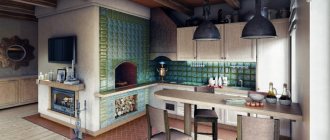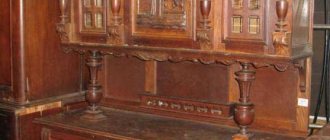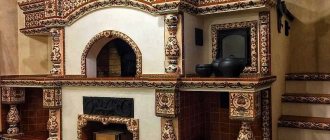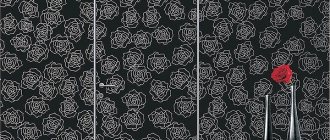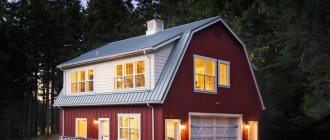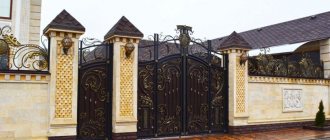Home » Type » House
House
Alyona
40107 Views 1 comment
About ten years ago, fireplaces began to be sold en masse - these are beautiful fireboxes of different sizes, made with a variety of decorative finishes. Thanks to the variety of types of portals, such fireplaces began to be installed in almost all private homes. Their beauty and high safety (the firebox is closed under glass) attracted many. For several years, they successfully replaced ancient Russian stoves. Till today…
A little history and facts
The stove is part of Russian folklore! There is no exact information when the prototypes of these structures first appeared. However, at first they had a completely different appearance, little reminiscent of the Russians we are used to. And only recently people began to build them in design and appearance similar to their analogues. Today, such structures are part of houses in Russian villages, where there is only stove heating and there is no talk of any gas. People use them to heat their houses, cook, heat food and bake with them.
The stove is part of Russian folklore
Pechka is a fairy-tale character
Despite its centuries-old history, the Russian stove has successfully survived to this day. It can be seen both in villages and small towns, and in our museum.
Another stove in our museum
The stove with a stove bench has become a worthy character in Russian epics and fairy tales. Emelya rides it. She saves children in a fairy tale about geese and swans. Baba Yaga loves to roast her captives by placing them on a shovel and putting them in the oven. Ilya Muromets has been lying on the stove for thirty and three years.
Our grandmothers, grandfathers, and great-grandfathers could not imagine life without a stove.
Come to our museum and see all the exhibits for yourself. You can view the program for visiting the museum here.
What does a traditional Russian stove with a deck consist of?
The Russian stove is quite massive, its weight reaches several hundred kilograms, so it needs a foundation. In the old days, its role was played by old stones and logs, which were laid out in the base. Today these are reinforced concrete or brick masonry.
It is better to plan construction at the stage of creating a house project. If the structure already exists, the foundation still needs to be made strong!
Essential elements:
- The lower part is the base (pods). It has a niche for storing fuel or kitchen utensils. Using this base, the combustion chamber is raised to the desired height.
- A vault-trough covers the top of the ovens. A layer of sand or clay is poured onto it. This technology is used to retain heat.
- The bottom of the firebox (under) is made with a slight slope towards the rear wall. This is done so that the fuel burns evenly in the chamber.
- The stove firebox consists of two parts: the cooking chamber and the firebox. The cooking chamber is clean without logs and ash, since the fuel is placed in the far chamber - the firebox.
- There is a vault above the firebox - this is the ceiling that separates the firebox and the lower part of the deck.
- The sunbed can be built along the entire length of the firebox. When the fire burns there, heat spreads to the lounger.
- The chimney is installed above the first chamber where food is prepared. Along the way, a valve and a viewing window are installed. Using a damper, the intensity of fuel combustion in the stove is regulated.
The Russian stove is quite massive
Depending on the design features, they may have steps leading to the sun lounger. Also, small shelves are often made along the chimney in order to install decor there.
What are we going to build?
Heat transfer: with one firebox - 2100 kcal/h, with two fireboxes - 3000 kcal/h. The back and side walls with one firebox emit 1200 kcal/h, the front wall - 400 kcal/h and the ceiling - 500 kcal/h. With two fireboxes, respectively: 1750, 550 and 700 kcal/h. Under the stove hearth there is a storage area for storing grips, pokers, scoops and other firebox accessories. The stove can heat a room of 30 m2.
1 - waterproofing; 2 - fine gravel and river sand mixed with broken glass.
Order and its description
Let's get started:
- It is better to build the 1st row using foundation mortar.
- The 2nd, 3rd, 4th rows are laid out like a well, but leave space for a niche in the oven. The suture dressing system must be followed.
- The vault is laid from the 5th row. Heels are hewn out to support the bricks, and formwork is made for masonry.
- 6th, 7th rows - erect a vault. Performed using a suture ligation system.
- The 8th, 9th, 10th rows are made in one brick. In the 8th row the arch closes.
- The 11th row covers the “cold stove”. The well is being filled up. The backfill is leveled so that a slope is formed.
- In the 12th row the floor is laid. The brick is simply laid on the sand. To level the hearth so that the surface is even, sand is poured onto it and sanded. It is better to use hearth bricks for this.
- 13 - 16th rows - laying the crucible. The walls are built with ¾ bricks 19 cm high. The bricks are not connected, only the seams are tied. The material must be beveled at 45° to install locks.
- 17th row - the back wall and mouth are formed. A frame is being built to form the roof of the cooking chamber. For this, a brick placed on its side is used. They cut off their heels. The roof of the cooking chamber is also laid out here.
- 18th row - we begin to build the walls of the furnace. We fill the area between the cooking chamber and the walls with the following materials: sand, clay, broken brick.
- The 19th row is placed in the shape of a semicircle. We block the opening above the pole.
- In the 20th row, the bricks are placed so that the hole above the pole is reduced and the walls are leveled. The overpipe must be laid out evenly, in no case in steps. To do this you will need to chip away the brick. A ceiling is installed under the channel for the samovar.
- The 21st row repeats the laying of the 19th.
- The laying of bricks above the vault is completed in the 22nd row. On the right side of the pipe we cut off a brick to lay the samovar. This ensures freedom for flue gases to pass through. A chamber for soot is placed here. The masonry above the vault is leveled.
- 22 - 32nd rows the over-pipe is laid out. We install valves (a samovar does not need a valve because it is closed with a lid). We form the pipe channel. Its parameters are two bricks 26x26 cm.
- Next, the pipe is laid out. The damper frame is made from a corner measuring 25×25×3 mm. You can use a sheet or strip. One or two handles must be attached to the damper.
Damper design
The design of the damper is shown in the figure (“Dash”, 1 - sheet made of roofing steel; 2 - handle made of strip steel; 3 - legs made of strip steel for stability of the damper; 4 - frame made of angle steel 25x25x3 mm).
It should be noted that the frame for the damper must be made of angle steel 25x25x3 mm. It is highly advisable to also make a frame from strip or angle steel and insert it into the masonry of the mouth, securing it accordingly. In this case, it will be the formwork when making the arch.
1 - roofing steel sheet; 2 — handle made of strip steel; 3 — legs made of strip steel for stability of the damper; 4 - frame made of angle steel.
Modern Russian stoves: what are they?
May vary in size and functionality. Traditional options have dimensions: length - 2.5 meters, width - 1.5 meters. Products can be of different sizes:
- small (178*124 cm);
- medium (213*147 cm);
- (231*160 cm).
In rare cases, furnaces can be built to non-standard sizes.
But few people were satisfied with the old ones - unattractive appearance, the ability to cook only inside the hearth, limited capabilities. Thanks to the work of craftsmen and changes in designs, Russian stoves have regained popularity. They have everything you need to heat your home, cook food and more.
Modern version
So, the latest additions:
- equipped with a cooking floor. Such designs are multifunctional and can replace any hobs and stoves;
- with fireplace. This option is a new trend. Its peculiarity is that the rear wall of the firebox structure is led into another room through the wall. Thus, it turns out that one design combines two: a fireplace with a flame effect and all the magnificent sounds of crackling wood, as well as a classic Russian stove that heats the house, has a firebox for cooking and a stove for cooking;
- with a bed. In the classic versions it was very large. Three people could fit on the sun lounger. An analogue has a sunbed, but only smaller. It is enough for one person to live comfortably. However, this disadvantage can be easily compensated for by an attached trestle bed.
According to fire safety rules, all furniture and equipment must be at a distance of 1 meter from the firebox!
Such designs are multifunctional
Pros and cons of designs
In addition to beauty and warmth, they have some advantages:
- uniform heat transfer and accumulation;
- high level of efficiency;
- bottom heating The classic versions were devoid of this. Only after some time, builders modified the stoves, making them more practical to use. This feature makes it possible to heat the room as a whole;
- high security. Since all structures are made of brick, the walls of the furnace do not heat up to such a temperature as to cause a fire or burn;
- built-in stove. Enables housewives to prepare food in their usual way;
- long service life. A properly made structure can last more than 30 years.
Minuses:
- you will have to stockpile solid fuel for the winter;
- the firewood will have to be dried, since wet wood cannot be placed in the firebox;
- When heating a house with a Russian stove, excess waste from the fuel occurs.
Warm and cozy sleeping place
The Russian stove cannot be called an ideal device - it has positive aspects and shortcomings. For example, in order to learn how to cook in it, housewives will have to go through a long training phase. For ignition you will need firewood, which will have to be prepared. These are, of course, not the electric or gas boilers that everyone is so used to. But the Russian stove also has a lot of positive aspects:
- there is an opportunity to cook excellent dishes. They turn out very tasty and differ from those cooked on stoves;
- depending on the design features, the Russian stove can be equipped with a sun lounger, allowing you to relax comfortably during the cold season. It can also have shelves;
- and finally, the effect of the flame, the sound of crackling logs and flickering fire - no device can replace this.
Russian stoves in the interior
Despite the development of technology and the appearance on the market of fashionable cast-iron fireboxes, which are framed in various decorative portals, the Russian stove still remains popular. Of course, it has changed not only externally, but also structurally. It has become more practical, convenient and safe; in addition, its design uses construction technologies and materials that can increase efficiency, as well as the aesthetic component.
Has advantages and disadvantages
Advantages
Wooden houses are the basis of the architecture of ancient Rus'. And, despite the development of technology and the emergence of building materials from which buildings are erected, wood still occupies a special place. Such houses are filled with comfort, and the Russian stove only complements the extraordinary spiritual atmosphere. The installation of a Russian stove in a wooden house must be carried out in compliance with the safety requirements established by our legislation.
Brick
Made from brick - this is a classic. Previously, such structures were built from homemade clay bricks, which were fired over a fire. The products are large in size due to the presence of a hob, a compartment for baking, and a lounger for relaxing.
The brick version is a classic
Advantages:
- Brick takes longer to cool than other materials. A stove built from it will give off heat longer after the fire dies out. As a result, the rooms will remain warm for a long time.
- A large structure can heat even a large house with several floors. This is possible if it is installed in the middle of the house, and the chimney is led up inside the walls that separate the rooms on the second floor. Today, the chimney is no longer made of ordinary brickwork. It is made from galvanized or stainless steel pipes that run in the middle of a compartment located inside the walls. And if ventilation grilles are made in the compartments along the chimney, then the heat emanating from the chimney will spread throughout the rooms.
- The brick does not heat up to a temperature that could create a fire. This building material is quite durable and practical. It can be used as a basis for applying decorative plaster, gluing with tiles and other finishing materials. Moreover, it is capable of serving without restoration for 30 years.
- The cost of such a design is not high compared to purchasing a cast iron firebox and a marble portal. It is worth noting that most of the cost is allocated to creating a high-quality foundation.
Modern and stylish
Unfortunately, like others, brick ones are not without their drawbacks. The main thing is the fact that for a brick structure you will have to build a powerful foundation. It can be a monolithic or reinforced concrete structure. If you install a brick one without a foundation, the floor may sag under its weight.
Precautionary measures
A Russian brick stove cannot be installed in all parts of the house. The location directly depends on the structural features of the building. It is better when the idea of construction appears at the stage of designing a house. Then it is possible to correctly calculate the location, as well as make an appropriate foundation.
If the house has already been built, then you will need to dismantle the floor in the place where the hearth will be installed to the base and make a scaffold.
Russian fairy tale at your home
Other options
Among the variety of options for installing heating systems in wooden houses, it is worth highlighting two main ones:
Fireplace stoves are iron fireboxes with a large viewing window. They can have a hob and are not framed by anything. Minus - the walls of the structure become very hot and can cause burns or fire.
Cast iron fireboxes are beautiful fireplaces that can heat large rooms. Many manufacturers make fireboxes of different sizes that have lifting mechanisms to open the firebox; the protective glass can be oval, prismatic or straight. The fireboxes are equipped with a slide damper, a mechanism for adjusting the combustion intensity. The downside is the high cost of fireboxes and portals.
Finish with beautiful tiles
Recently, these options have become less common for installation in private homes. Despite their attractiveness, they are inferior to traditional Russian stoves in many respects.
How did you wash before?
The internal structure of the Russian stove provides for long-term heat retention inside its furnace, especially if, after firing, the vent is closed with a damper. This design allows not only to maintain the temperature in the room, but also to keep heated water and food placed in it warm. The nuance of maintaining the water temperature is very important, since they usually “started” the stove in the morning, and washed after all the preparations, in the late afternoon.
Old Russian stoves are massive in size; two adults could easily sit inside the stove while doing water procedures. There was still space left for two pots and a broom.
After the day's preparations were completed, the stove was cleaned of ash, soot and soot. Before washing, the surface on which they climbed was covered with straw or small planks, so as not to get dirty on the way back. After all the actions, the laundering process itself began.
Old people, small children or babies were washed in the stove. In short, those who, due to circumstances, could not get to the bathhouse or were not in good enough health. Sick family members were also not taken to the bathhouse, especially in winter - they were washed in the stove. Small children were “transferred” to the oven on a special shovel, where one of the adults received them, and old people on small linden boards in a lying position.
Children were placed on special shovels
Young unmarried girls also used the stove when they needed to wash themselves. This is due to the belief that angry spirits live in the baths - banniki and kikimoras, who are capable of committing all sorts of atrocities to a girl. If the young beauty left the bath accessories in the wrong place or disturbed the peace of the spirit with any actions, he could get angry and prop the door, letting in a couple, or knock over a basin of boiling water on the culprit.
Since Rus' had its own rules for going to the bathhouse, unmarried girls could only wash with children or young sisters, who also did not have spouses. In some villages, a lonely girl going to the bathhouse was equated with a sin, and the girls had no choice other than washing in the oven.
Free women were only allowed to bathe with their sisters
Washing at home under the above circumstances was much calmer. Each hut had a red corner in which icons were placed, and it was possible to perform water procedures without fear of evil spirits.
They washed themselves in a Russian oven for medicinal purposes. Family members who fell ill with “dandruff” (cough, presumably bronchial) were placed in the oven, where tubs of special decoctions awaited them. Before being sent to the oven, a similar herbal decoction was given orally, and the body was coated with a specially prepared dough. This was done in order to warm up the body as much as possible both outside and inside. A scarf or cap was placed on the patient's head to prevent heat stroke, called "fumes."
Those suffering from certain types of skin diseases were also washed in the oven. Such people were not taken to the bathhouse, so that the disease would not affect other family members with the water. After washing, the broom, along with the flooring on which the patient was placed, was burned. During the subsequent firing of the furnace, the disease was, as it were, “burned”, not allowing it to get out. This method of cleansing helped to localize the disease, and subsequently get rid of it altogether.
Decorative finishing
Building materials make it possible to finish the stove in a variety of styles. In addition, they have a beneficial effect on the resistance of bricks, as well as mortars used in its laying, to various negative influences.
Truly Russian style: mud and tiles
In the old days, one material was traditionally used - mud (clay-based plaster). Then it was covered with ordinary whitewash. This finishing method is not durable, since during kindling, smoke settles on the surface, making the whitewash gray. Although it is necessary to highlight the beauty of the painting of such stoves, their attractiveness and truly Russian style. Nowadays, rarely anyone uses this method of decoration, as more and more people prefer practicality.
Stone finishing
The most common classic option is decor using ceramic elements made in the form of boxes. The main advantage of this material is its attractiveness, as well as practicality. Tiles are able to retain their original appearance for a long time. The main disadvantage is the high price
.
Peculiarities:
- the cladding is laid from bottom to top;
- a special gypsum composition is used for grouting joints;
- There are a variety of tile patterns available on the market. These can be either smooth tiles or embossed ones with different patterns.
Using tiles for decoration, it is possible to choose the desired color, pattern, relief so that it fits the overall style of the room. This is the best material for finishing Russian-style stoves.
The cladding is laid from bottom to top
Modern materials
The variety of materials makes it possible to decorate a Russian stove in any style. All this allows it to fit harmoniously into absolutely any interior. Among the most common it is worth highlighting:
- facing brick;
- ceramic tiles or porcelain stoneware;
- artificial stone of various types;
- natural wood can be used for decoration;
- a natural stone;
- plaster and paint.
These materials are very practical and reliable. To give them a new look, just wipe the surfaces with a damp cloth. However, they are not without drawbacks. Some, for example, like ceramic tiles or granite, cannot harmoniously fit into any style.
You can cook many delicious dishes in it
Plaster and paint
The plaster and paint looks very nice. This finishing method is for interiors in a minimalist style. In this case, the choice of color and texture is limited only by a flight of fancy and the general style of the room. Using paint and plaster, you can visually reduce the size of the stove or, conversely, increase it. Plaster and paint are often used to create Russian-style decor. It allows you to make various designs and patterns on its surface.
Literature about furnace business
The publication of books on stove design began in 1795, when the architect Nikolai Aleksandrovich Lvov wrote two brochures “Russian Pyrostatics”. As for air heaters, such engineers and architects as Derschau, Voinitsky, Lukashevich, Sviyazev took part in their improvement.
Ivan Ivanovich Sviyazev played an important role in the stove construction of the 19th century, writing a “Training Guide to Architecture” in 1839. In the book, for the first time in the history of Russian heating technology, the architect gives a calculation of the speed of movement of flue gases in the channels and determines the cross-section of the chimney. In 1867 he published the book “Theoretical Foundations of Kiln Art.” In it, the architect summarized all his knowledge and experience over 50 years of his practical activity. He also invents a sealed fire door and an ash pit (a place for ash under the firebox).
Silviusz Boleslavovich Lukashevich distinguished himself in improving stoves. In 1880, he published a “Course on Heating and Ventilation,” where in the section “Stove Heating” he outlined the theory of calculating all elements of heating stoves. This course has been introduced into all educational institutions.
Engineer Ivan Dmitrievich Flavitsky compared brick and metal stoves. His study “Healthy and harmful heating and improvement of residential premises: a popular scientific presentation of hygienic information for practical application to heating and ventilation of buildings” is still referred to by stove makers when analyzing heating devices.
Already in 1938, engineer Leonid Alekseevich Semenov made a calculation of the heat transfer of heating stoves and the heat resistance of residential premises, which was published in the journal Heating and Ventilation. Over the course of 20 years, starting in the 1930s, L. A. Semenov published about a dozen books about furnace business.
Return of traditions
It cannot be said that the Russian stove in the house is a museum exhibit that has unexpectedly returned from the past. In fact, it never disappeared; moreover, it is part of some Russian outbacks that are unfamiliar with main gas.
The massive return of the Russian wet nurse to homes spoiled by civilization is not a tribute to fashion. Most likely, what plays a role here is the desire of people to feel comfortable and cozy in the house, to fill it with the pleasant aroma of baking and to meet with the family in front of an open fire for a delicious dinner cooked in a real Russian oven. After all, not a single miracle of technology will give the sensations and emotions that people experience when they see a flame.
Will help you feel comfortable and cozy in your home
A Russian stove, finished with high-quality materials, does not look like an alien in the house. Today it has become more compact, practical and wear-resistant. A wood-burning stove, depending on its design features, is placed not only in the kitchen, but also in the living room and dining room. For the convenience of housewives, craftsmen integrate everything they need into them, right down to hoods.
A Russian stove without built-in hobs can easily take a central place in a library or bedroom. A lounger can easily replace even the most comfortable chair or even a sofa.
To choose the most suitable project for your home, you need to consider several options in detail. They differ in size, functionality, and of course cost.
Installing a Russian stove in a country house is a job only for professionals. Regardless of construction skills, the construction of such a structure requires not only skills, but also knowledge of its features and technologies.
Interesting design solution
"Alya-Rus" - a designer hit
This model has quite compact dimensions. It does not have additional equipment, such as a hob, a large sun lounger or the ability to observe the flame effect. This option is suitable for a small kitchen. Such a stove is decorated with decorative elements that are associated with Russia. It looks light and charming in a wooden house. Peculiarities :
- Despite the primary simplicity of the decor, such a stove should not be overloaded with accessories. A few decorations will be enough;
- it can be installed not only under the wall. Due to its compactness, it will look good in the center of the kitchen, if space allows.
This option is budget friendly. And if you want a Russian stove in your home, but your budget does not allow for luxury, you can choose this option.
Suitable for rustic style homes
Where did the custom come from?
Even in ancient times, Russian people understood that cleanliness is the key to health, and they tried to observe its manifestations in everything: in everyday life, in clothing and, most importantly, in taking care of their own body.
It is not for nothing that ancient Russia was not affected by the numerous diseases that raged in Europe and were caused, first of all, by a complete lack of personal hygiene and unsanitary living conditions. Travelers visiting our country often noted that the inhabitants of Russian settlements look completely different: fresh clothes, clean hair and a washed face. This is not surprising, because in Rus' at that time only the lazy could not wash.
Antique stove from 1890
Baths were a mandatory attribute of ancient Russian settlements. If the family did not have enough strength or funds to build a bathhouse, water procedures were carried out in stoves.
It is difficult to establish where exactly the custom of washing in the stove began. Different parts of Russia have preserved evidence of the use of this method since the 15th century.
This tradition extended not only to villagers, but also to city dwellers, since the stove was the only means of heating the premises. According to ethnographers, the custom of washing in the stove survived among some population groups until the 20th century.
Where to install a Russian stove?
Today it is difficult to surprise anyone with the presence of a fireplace or cast iron firebox. Almost all country houses are built taking into account these structures. But the Russian stove will cause not only surprise, but also admiration.
Interesting design option
The moment the question arises about installing it in a country house, nuances immediately arise that no one had thought about before.
It is better when the issue of installing a Russian stove is decided at the stage of planning a country house, since nuances arise that are better to be resolved immediately.
In the living room
The living room is the calling card of any home and a private home is no exception. In this room it will be a bright accent that attracts the eye. Therefore, there is no need to look for too modest design options. Its size must be selected depending on the area of the room.
All pieces of furniture should be kept away from the structure.
In the interior of the living room
Depending on the interior and size of the room, stoves can be of different designs with or without a hob. The following stoves can be installed in the living room:
- If it is large in size and has a fairly bright design, for example, decorated with tiles, all other furniture in the living room should be in muted tones. You should not use bright decor or saturated colors. Then they will not distract attention from the main element in this room. The bed can be decorated with handmade blankets, beautiful and bright pillows. It is better to use dim light. They have additional shelves and a large bed. There is no hob or baking compartments - only one cooking compartment.
- The Russian stove in the interior should look more modest. For finishing you can use artificial stone, porcelain stoneware, tiles. The strict design of the stove is in harmony with expensive furniture. Such designs should not have a hob or baking compartments. But the presence of a large bed is mandatory.
- The main part of the stove is in the kitchen, and the combustion part is moved into the living room. The firebox part can be framed in marble if the interior of the living room matches or it can be made similar to a fireplace. In addition to it, you can install special sets for the fireplace: firewood, broom, dustpan, poker. In the immediate vicinity of it, you can put a beautiful carpet on the floor or install a soft and cozy sofa. However, we must not forget about fire safety rules. If the firebox is open, you need to install a protective mesh or glass.
The strict design of the stove harmonizes with expensive furniture
Installation in the kitchen
The choice of a Russian stove for the kitchen depends on the size of the room. If it is large, you can install a large stove that will be multifunctional:
- baking compartment;
- multi-plate hob;
- compartment for dishes;
- large bed for several people.
If you are choosing a design for a wooden house, it is better to give preference to the truly Russian style. The decor can be made in several ways: using building materials (plaster and paint) or traditional mud . Such designs will look harmonious and fill the kitchen with coziness and comfort.
The kitchen is the ideal place for this product
Features and nuances:
- Do not install household appliances in close proximity to the stove. This may result in a fire.
- The dining area should be located at a distance. Otherwise it will be very hot to be at the table.
- The kitchen should be light and spacious. Therefore, if its dimensions are insufficient, it is better to abandon the idea of construction.
- The Russian stove in the kitchen should not be overloaded with unnecessary decorative elements. She herself will act as a bright accent.
- If this room is spacious enough, you can use bright decor on the stove. These can be decorations in the Russian style or tiles with beautiful designs.
Choosing a stylistic direction
Modern style
This style welcomes deep blue furniture, clear straight lines, multifunctional household appliances and an abundance of gloss. It is acceptable to use other colors as accents, such as white and gray.
Classic
The classic set is a structure made of natural wood and equipped with a countertop made of natural stone.
Marine shades can be present not only in the colors of the facade, but in the form of textiles - they can be used in tablecloths, curtains, upholstery, potholders and towels.
The blue color scheme is in stunning harmony with the plank floors and exquisite decor.
Loft
When looking at a photo of a blue kitchen interior, decorated in a loft style, no one has any doubt that the rich blue set perfectly complements the concrete floors and red brick walls.
Country
The atmosphere in such a kitchen breathes the comfort and warmth of a home. Blue furniture goes well with natural wood. Complementary elements can include woven rugs, hand-embroidered tablecloths, and painted ceramics.
Recommendations from the designer
- Apron for the kitchen - 115 photos of modern ideas. Review of the best apron ideas with an exclusive design + instructions and video
- Plasterboard ceiling in the kitchen: design ideas, application features and current ceiling structures (100 photos)
- Kitchen design 10 sq. m. - real photos of the application of stylish solutions and an overview of the most beautiful combinations in design
Sea style
Blue is the best color for creating an interior in a marine style. The optimal scenario would be to combine a kitchen set in a blue palette with white trim. Don't forget about accents. Themed accessories and textiles with marine patterns can play their role.
Conclusion
A Russian stove in a country house is an opportunity to fill it with warmth and comfort. However, before its construction, everything needs to be carefully planned, especially if the construction will be carried out in a residential building.
Brings not only color, but also many possibilities
Pitfalls that you may encounter during construction:
- This design will look harmonious only in rooms with a large area. Otherwise, there is a chance to turn the kitchen or living room into a room of aesthetic shame.
- You should not flatter yourself with the hope that you can build such a structure yourself without construction skills. Here are a few examples of how one wrong step can ruin the entire creation. The chimney must be at a certain distance from the ridge, and depending on this, have a certain length. Otherwise, all the smoke and fumes will end up not in the chimney, but in your room. The foundation must be calculated to the smallest detail, otherwise you risk the integrity of your floor.
- In view of this, construction should be trusted only to professionals. You can only choose the design of the stove and the availability of certain functionality.
Looks harmonious in rooms with a large area
A Russian stove in the house brings not only flavor, but also many possibilities, but only if it is built by professionals. Advantages of a Russian stove in the house:
- Food cooked in the furnace cannot be compared in taste to any other. No restaurant in Russia will prepare such delicious pastries or other dishes for you.
- If the stove is built correctly, it can heat not only the first floor of your house, but also the second and third. But only along the chimney pipe. However, the first floor, even in severe frost, will be warm.
- A Russian stove will heat a room much faster than fireplaces, gas heating or any other.
If you are thinking about installing a stove in your home, plan everything carefully and think it over. Only the right approach to the construction of a Russian stove will give the expected result. The work should be entrusted to professionals who have experience in construction and know everything about the construction and installation features of such structures.
Construction of a brick kiln requires the correct choice of material and mortar for masonry. If it will be covered, you need to choose the right facing material and mortar that will hold the stone or mosaic.
